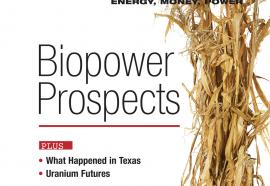MISO
DR Distortion
Are subsidies the best way to achieve smart grid goals?
FERC has proposed that wholesale energy markets should subsidize load reductions with full LMP (locational marginal price), without deducting the customers’ retail savings. Such a policy could distort the market, and other solutions might achieve the same objectives more efficiently.
One if by Wholesale, Two if by Retail
Which path leads to the smart grid?
A fierce debate has erupted in the utility policy community, with battle lines drawn within FERC itself. In the effort to improve system efficiency, two competing alternatives stand out: to build the smart grid on large-scale demand response (DR) programs, or to build it around consumer behavior in retail markets.
Every Last Penny
Transmission cost allocation, the worth of the grid, and the limits of ratemaking.
A look at the issues that the Federal Energy Regulatory Commission must address concerning allocation of costs for certain high-voltage transmission lines 500kV or greater, planned for the PJM region, in the “paper hearing” on remand from the 7th Circuit federal court decision that rejected a socialized, region-wide sharing of costs among all utilities and customers across the RTO footprint.
Beyond Intermittency
Forecasting brings wind energy under control.
Advancements in forecasting have improved the reliability of day-ahead and hour-ahead estimates of wind generation. Wind never will behave like a base-load power plant. But as system operators integrate wind forecasts into their planning and market processes, they’re transforming intermittent wind energy into a variable but reliable resource.
Outsmarting the Grid
A trio of eager tech startups confronts an industry intent on preserving the status quo.
In light of all the excitement created by smart-grid regulatory initiatives and stimulus funding, three clever tech startups have come forward with proposals for novel grid projects. In California, Western Grid Development proposes to install energy storage devices ranging in size from 10 to 50 MW at various discrete and strategic locations in PG&E’s service territory where the California ISO has identified reliability problems. Second, a company called Primary Power proposes to deploy a total of four advanced, 500-MVAR static VAR compensators (SVC) at three separate locations within the PJM footprint. Third, in Clovis, N.M., Tres Amigas plans to allow power producers to move market-relevant quantities of electric power and energy between and among the nation’s three asynchronous transmission grids: ERCOT and the Eastern and Western Interconnections.
3Rs for Power And Demand
Dynamic monitoring and decision systems maximize energy resources.
The operations and planning rules for integrating variable resources aren’t the same across the electric power industry in the United States at present. Opinions are somewhat divided about what these should be, as well as the assessments of potential benefits and costs. In order to support sustainable deployment of variable resources at value, it’s critical to identify major sources of potential problems and to proactively design and implement a systematic framework for managing their unique characteristics as reliably and efficiently as possible.
Negawatt Pricing
Economists take sides in the battle for DR’s soul.
Back when the U.S. economy and power consumption still were bubbling, PJM reported in August 2006 that customer curtailments during a week-long August heat wave had generated more than $650 million in market-wide energy savings—all at a mere $5 million cost, as measured in direct payments made to the demand response (DR) providers, set according to wholesale power prices prevailing at the time. Where else but the lottery can you get an instant payoff of 130-1?
'T' Party Revolt
Transmission expansion costs are spread unevenly, driving a wedge between utilities and regions.
Back in June, the Bismarck Tribune ran an interview with North Dakota Public Service Commissioner Tony Clark that showed just how difficult it is to build national consensus for renewable energy.
RTOs and the Public Interest
Defining the mission when the consumer plays second-fiddle to the needs of the market.
Six months back, when ISO New England was mulling over various reforms that FERC had mandated last fall in Order 719 for the nation’s six regional transmission organizations and independent system operators (RTOs and ISOs are interchangeable terms in this column), the ISO refused point blank to include in its mission statement a proposal by stakeholders that it should operate the bulk power system at the “lowest reasonable cost.”









